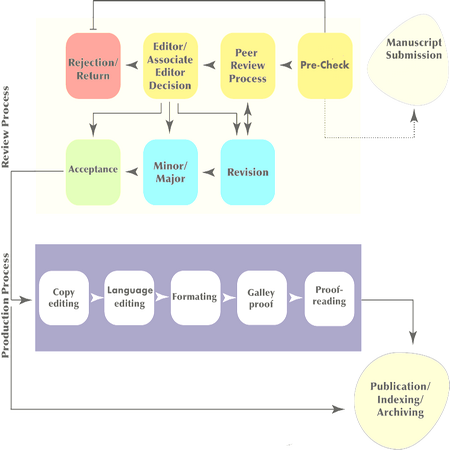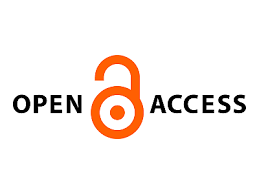Editorial Procedures
Editorial Procedures
1.Duties of Editors
A systematic peer-review process is run by the Journal of Economic Growth and Entrepreneurship (JEGE). The journal aims to honor the publishing principles and perform the roles of editors through a double-blind peer review by at least two external reviewers, followed by a definitive acceptance/rejection vote by the Editor-in-Chief, or another academic editor accepted by the Editor-in-Chief.
The Editor-in-Chief is responsible for the academic quality of the method of publishing, including decisions on admission, recognition of Guest Editors and special issues, and new members of the Editorial Board.
2.Pre-Check
A competent in-house Managing Editor may verify all published submissions obtained by the Editorial Office and determine whether they are adequately written and whether they obey the journal's ethical policies. Until peer-review, manuscripts that do not match the ethics guidelines of the journal or do not follow the journal's criteria will be rejected.
Following these reviews, the Managing Editor shall contact the Academic Editor of the publication, i.e. the Editor-in-Chief in the case of daily submissions, or the Guest Editor in the case of Special Issue submissions, or the Member of the Editorial Board in the event of a conflict of interest, using the Paper Preparation Level (MRL) to determine if the manuscript fits the journal scope.
And if it is sound in scientifically sound. Without scrutiny, we will refuse a manuscript if it contains inadequate content; it is formatted incorrectly; it is improperly presented and vague.
In general, editors do not associate directly with the authors and it is highly relevant if one of the authors is a member of the editorial board. Thus, preferential care will not be provided to them. Incomplete submissions will now be unsubmitted by our editorial assistant if the journal does not obtain the necessary documentation within 5 days.
The Principal Editor or Associate Editor will handle manuscripts for contribution, originality, relevance, and presentation that undergo the initial examination and supervise the review process.
3.Peer-Review
Once the manuscript meets the initial controls, at least two additional peer-review experts will be appointed to it. A double-blind analysis is used where critics are unaware of the writers' identities and the authors are unaware of who has read their manuscript. Posts on peer review are private and can only be disclosed with the reviewer's express permission.
In the case of daily submissions, experts will be invited by in-house assistant editors, with suggestions by an academic publisher. These experts can also include the members of the Editorial Board and the journal's Guest Editors. Reviewers may not have written in the last five years with any of the co-authors and should not work at the time or cooperate for all of the bodies of the co-authors of the manuscript submitted. See Reviewers' Roles in Journal Ethics.
4.Editor Decision
After peer review, approval decisions on manuscripts are taken by an academic publisher, either the Editor-in-Chief, a Guest Editor, or another appropriate member of the Editorial Board. We require the academic editor to review the following before making an editorial decision:
-The suitability of selected reviewers;
-Adequacy of reviewer comments and author response;
-Overall scientific quality of the paper.
The author may choose from: "acceptance without revision", "acceptance after minor revision", "reconsider after major Revisions", "rejection and encourage resubmission" and "rejection"
4.1.Acceptance without revision: These articles are received and written as they are received.
4.2. Acceptance after Minor Revisions: In theory, the paper is approved after revision on the basis of comments by the reviewer. For small revisions, writers are given five days.
4.3.Reconsider after Major Revisions: The manuscript's approval will depend on the revisions. If any of the reviewer's remarks will not be updated, the author has to give a point by point address or provide a rebuttal. Just one round of major revisions is normally permitted. Writers will be asked to resubmit the revised paper within a reasonable time period, and the revised version will be returned to the reviewer for further comments.
4.4.Rejection and Encourage Resubmission: The manuscript will be rejected if additional research or experiences are required to validate the findings, and the authors will be allowed to re-submit the paper after additional studies or experiences have been completed.
4.5.Rejection: There are substantial deficiencies in the paper and/or there is no important original contribution. No offer of resubmission to the journal is made.
A letter of rejection is submitted to the relevant one in the name of Editor-in-Chief for the 'rejected' documents with explanations for rejection. Reviewers' suggestions are not mentioned. Insufficient originality, significant scientific errors, low quality of drawings, inaccurate manuscript type are the standard grounds for rejection.
While the peer review process will usually take three weeks after the manuscript has been published, a longer time of review may be required to complete the review process.
Using the Turnitin service, the editorial office may search again if there is any suspicion that a paper could contain plagiarism.
Reviewers make recommendations, and Editor-in-Chief is free to disagree with their views. If they do so, they should justify their decision, for the benefit of the authors.
Editorial autonomy is highly necessary and no party can intervene with editorial decisions (such as Publisher). In fact, without the approval of an academic editor, no paper is written and journal staff do not inform academic editors on approving or refusing posts.
The Journal of Economic Growth and Entrepreneurship staff or members of the editorial board (including the editor-in-chief) are interested in the production of their own scholarly jobs. At least two impartial outside reviewers are appointed to their applications. Decisions are taken by those members of the editorial board and do not have a conflict of interest with the author. In Publishing Ethics, please see Editors and journal staff as authors.please see Editors and journal staff as authors in Publication Ethics.
5.Revision
It is rare to approve a paper without revisions for publication-most articles are changed at least once in the light of input from reviewers and editors.
When it receives an updated paper:
-
-Minor changes will usually be assessed directly by the editor;
-
-If significant revisions were requested, the editor will usually return the manuscript to the original reviewers (unless they opted out of this).













